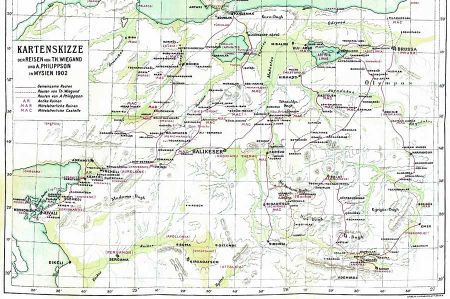Theodor Wiegand - Excavations and Travel
- Written by Portal Editor
Our visit to the Forest Fire Station of Dursunbey came together with the meeting of some Roman artifacts that justified our interest to further research in the history of Dursunbey or Balat, how the city was called until 100 years ago.
Quickly we found more clues to the ancient past, so in the name of an ancient town, just next to the modern city borders of Dursunbey, in Roman times called: Hadrianeia.
Hadrianeia was like the nearby cities Hadrianutherai and Hadrianoi, founded by the Roman Emperor Hadrian. The era of the city began in 131/132 AD. Hadrianeia should probably contribute the urbanization of the mountainous area Abrettene between the rivers Makestos and Rhyndacus. Located on the road between Hadrianoutherai and Kotiaion, Hadrianeia quickly developed into an important location for stamping coins, which greatly contributed to the prosperity of the city. However, during our research we found the name of Theodor Wiegand, a German archaeologist, who extensively traveled in the region and is also responsible for creating a map in 1902, showing some extra recordings about Balat.
Born as the eldest son of the physician Konrad Wiegand and his wife Ida on 30th of October 1864 in Bendorf at the Rhine River, Theodor Wiegand was a German classical archaeologist.
After high school Theodor Wiegand studied Art History, Archeology and Classical Studies at the Universities of Munich, Kassel, Berlin and Freiburg.
In 1894, he went to Athens, where he participated to the excavations on the Acropolis under the leadership of Wilhelm Dörpfeld. In 1895 he went to Priene as assistant archaeologist of Carl Humann. Priene is an ancient town, not far away from Didem. When Carl Humann became ill after three weeks, Wiegand continued the excavations. After Humann´s Death in 1896, Wiegand was appointed to succeed him as prospector in Priene and as director of the Berlin Museums based in Smyrna, today known as Izmir.
After 1899, he successfully completed the excavations in Priene, which is also called the "Greek Pompeii" because of the closeness of the city system and the good condition of the houses plans, he excavated, in collaboration with Hubert Knackfuß, parts of the ancient world city and commercial metropolis of Milet between 1899-1911. Here significant preparatory work was being undertaken because the excavation site was settled and the swampy terrain had to be drained during excavation. The hope of finding the archaic city Miletus, the philosophers Thales and Anaximander were writing about, which had been destroyed 494 BC during the Ionian revolt by the Persians, should not be possible. Instead, he pushed to open the Hellenistic-Roman layer with its magnificent representative buildings, including the famous Market Gate of Miletus, now one of the major works of the Berlin Pergamon Museum.
Further excavations took place in Didyma (1905-1911) and on Samos (1910-1911). Wiegand's latest excavation was the reinvestigation of Pergamon in 1927, where he discovered the Arsenale at the castle and uncovered the location of Asclepius outside the city sanctuary.
Theodor Wiegand was foreign director of the Berlin Museums of Constantinople and beyond that scientific attaché at the German embassy in Constantinople from 1899 to 1911. As thus he was the diplomatic arm of the museums and he represented the archaeological interests of Germany in the Ottoman Empire and coordinated the increasing amount of German excavations in the East, f.e. in Mesopotamia.
1912 Wiegand went back to Berlin to take over the management of the antiquities department of the museums in Berlin. Between 1911/1912 and built by the architect Peter Behrens a family home "Haus Wiegand" was built, a representative neoclassical villa in Berlin-Dahlem, today the German Archaeological Institute.
As Director of the Antiquities Department of Museums in Berlin, Wiegand was responsible for the construction and establishment of the Pergamon Museum on Berlin's Museum Island. In 1916 he acquired the enthroned goddess from Tarentum for the Berlin museums and in 1925, the Berliner the archaic goddess of Keratea, Attica.
In 1922 Wiegand has been included as a full member in the Prussian Academy of Sciences. In 1930 he retired from government service and in 1935 his birthplace Bendorf appointed him the honorary citizenship. He became a member of the medal "Pour le Mérite" for Science and Arts in 1931.
Wiegand died on December 19th, 1936 in Berlin on the long-term consequences of malaria.
Please read as well:
An Amethyst Mine in the mountains of Dursunbey
Open Air Stalactite formations at Dursunbay Cayi
-
-
-
-
-
-
https://www.alaturka.info/en/history/modernity/3303-theodor-wiegand-excavations-and-travel/amp#sigProId217cbebb11
